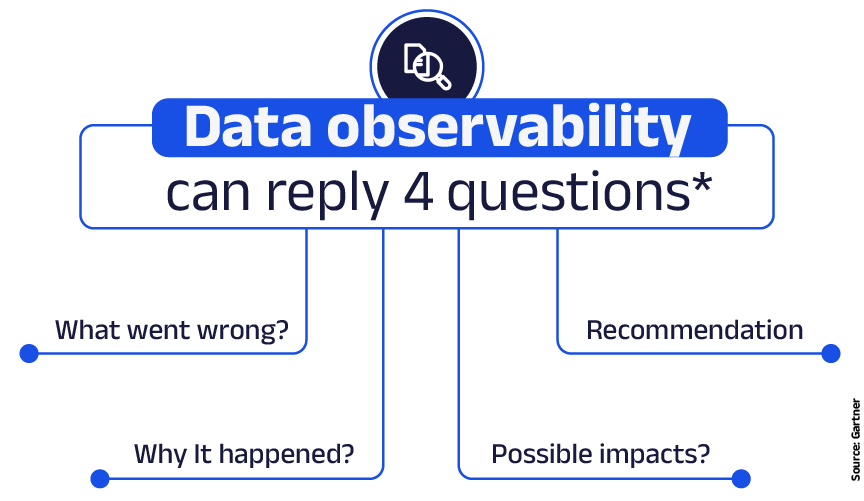Data Observability: a good diagnosis for your company
- 7 mins
It is a fact that digitalization has had an effect on all industries in the last decade. This situation has led leaders to adapt to the business world's demands constantly.
One of the business assets with the most significant impact is data, which is generated in high volumes and with incessant production. Therefore, companies have implemented reliable tools and strategies that allow them to manage thousands and millions of daily-generated data for the company’s development and stability.
One strategy to get accurate and reliable information is Data Observability, a concept that is expanding increasingly and here we delve into it.
Data Observability: What is it?
This term refers to the health and state of the data in a system or architecture. Data Observability involves multiple activities such as monitoring, alerting, classifying, and evaluating data, which builds the path for engineers to identify and solve problems immediately.
Gartner highlights observability as a way to find out pipeline status, infrastructure, and data landscape, a situation that informs you of anomalies, and gives you the chance to solve them the moment they arise.
Data Observability is involved in all data lifecycles and has an impact on DataOps and DevOps departments since it provides enough context to fix bugs in real-time and ensures it doesn't happen again. Keep in mind that a reliable pipeline guarantees results to make good decisions and data observability is responsible for that.
Data Observability and Data Quality
As you can see, observability has certain characteristics that can get confused with quality. However, it is important to stress that for the first concept to exist, there must be quality previously. Nonetheless, it should be noted that, by itself, observability does not guarantee data quality.
Before aspiring to a great observability process, your team or IT department should focus on having reliable data, which is possible thanks to the tools that help clean it. Thanks to this, later on, it will be easier to detect database problems and give them an optimal solution.
Data Observability and Data Governance
Just as there is a link between observability and data quality, there is also a connection with data governance. In this Data Governance guide, we delve further into the term, but it is necessary to emphasize that this strategy can be perfectly combined with observability.
While Data Governance ensures accessibility, visibility, and security of data and its compliance with organizational standards and policies, observability alerts when there are issues related to quality or information availability.
Data Observability role

One of the most relevant groups in organizations with objectives aimed at Data-driven is Data Operations or DataOps, an area that must ensure correct information management for those who seek data value and useful insights for decision-making.
DataOps use observability tools to reach their goals like testing, building and monitoring databases, and structuring pipelines. Everything mentioned above is attainable from the confirmation of formats, types, and values, anomaly review, and performance optimization of data pipelines1.
Data Observability has taken on an essential role for certain teams or organizations thanks to its benefits such as getting valuable and useful information obtained for companies and their stakeholders. Likewise, it avoids wasting time finding errors within your data flows, which represent a possible waste of economic resources.
In the words of Barr Moses, Data Observability has 5 pillars from which its importance can be demonstrated:
- Freshness: It refers to the fact that the stored data is up-to-date, as well as the frequency with which the information is updated or loaded since it is well known that the decisions based on it won’t be correct if this doesn’t happen, which results in lost revenue and time.
- Quality: This pillar is based on the data quality you work with, because even if pipelines are accurate, if the information is wrong, you will not be able to trust your data and its performance.
- Volume: Consider the database's integrity to obtain insights. This step will let you know if your rows and columns are exact or if there is excess or missing information.
- Scheme: Indicates when data is corrupted, and if it is necessary to monitor when there are changes, as well as who made them and with what purpose.
- Lineage: Thanks to this pillar, those who work with data can effectively locate when a piece of data was broken, since they have access to the impact, both upward and downward, that this break caused.
Data Observability benefits
Observability as of now is not considered essential, but it helps organizations that already adopted it more than it seems since its mission is to improve what has already been implemented and focus on the problem to seek an immediate solution.
The aforementioned leads to its benefits being accurate and useful for data professionals:
- Simplification: By having the ability to cover a data architecture from beginning to end, those who work with information can easily detect problems without necessarily having to resort to its origin and thus facilitate its analysis.
- Anticipation: It allows you to find errors that could rapidly grow. Actions can be executed to stop them and avoid bigger problems starting from observability, which leads to effective planning before these eventualities.
- 360 Vision: A piece of observability is a complete vision of the data, which is equivalent to having a good level of quality and integrity in it and later in the pipelines.
So far there already seem to be sufficient reasons to bring this practice to your company, however, it is important for us to answer one more question.
Why consider a Data Observability strategy?
If the data volume in your organization grows considerably or changes day to day, it is enough to consider implementing Data Observability in your business, since the time and resources you are devoting to its management may be diminishing other opportunities for growth.
Information management currently leads to scenarios that could never have been discovered, and the right technological tools are capable of catapulting your company through decisions since they were created to obtain data quality and eliminate errors.
Another benefit is if your data is stored in more than one location. Connecting and analyzing it from a single source will also give you better insights.
Use case of Data Observability
According to Sanjeev Mohan, despite being a recent concept, there already are several areas where observability can be pointed out for its participation, one of which is in business operations from effective pipelines.
The author underlines 5 fields of impact:
- Speed: The gaps between those who produce data and those who work with them are reduced, facilitating their analysis.
- Trust: Keeps active data ensuring its availability to maintain optimal quality.
- Costs: Exposes information that is not useful, thus eliminating resources that could cost data engineers space and time.
- Efficiency: One of the biggest advantages of observability is that if it is well executed, production errors can disappear.
- Innovation: Observability makes it easier for companies to migrate to other tools, and transform and implement new technological processes for constant evolution.
Conclusion
Achieving adequate data quality is a constant challenge that can be achieved with the help of practices such as observability. As you have read throughout this content, it has multiple impact areas and the way it improves processes is an advantage that every company would like to have.
By using an appropriate tool such as Arkon Data Platform, the path to gaining reliable information becomes easier due to its user experience design, and its modules developed for data integration, governance, and quality.
1 Mary K. Pratt, 2022.




